|
 Veterans were introduced and asked to stand and be
recognized. Then everyone heard from speakers Veterans were introduced and asked to stand and be
recognized. Then everyone heard from speakers
Ann Olson, Jan Funk and Paul Osman.
Olson, a member of the NAG Board, who worked tirelessly on the park
project, shared the statue’s history. She said, “Prior to this park
renovation, I always knew the statue guarding the entrance to this
park was known as the ‘Doughboy,’ but I never knew why it was given
that name.”
Olson said her research showed “the most accepted explanation for
‘Doughboy’ dates from the
Mexican-American War in 1846 [and] was a name given to members of
the American infantry because their uniforms were covered with adobe
dust and dirt, which made them look like they were covered in flour.
They were called ‘adobies’ then ‘dobies,’ and eventually
‘doughboys.’”
Olson said. “When Americans landed in France during WWI the French
people attached nicknames to all the foreigners. Several names were
given to the Americans, but one stuck, Doughboy. These men,
identified as Doughboys, were the frontline infantry during the
war."

Olson said, “Today, there are about 100 doughboy statues in parks
and memorials nationwide. Most of those statues, which were mass
produced in the 1920’s, show the doughboy in a position with the
right arm extended and the right leg bent back. This version is
called ‘The Spirit of America.’ "The designer chose this pose so
from the profile, the statue resembled the stance of the Statue of
Liberty.”

Olson said, “Our Doughboy is in a different pose,
called ‘Order Arms,’ which, in my opinion, makes him more unique
than the others. One possible explanation for the difference is our
statue was made before the ‘The Spirit of America’ statue was in
mass production."
Olson said, “In 1919, the Doughboy was a gift to the Elkhart
American Legion from veterans returning after WWI, from returning
vets, to honor those who didn’t make it back home after the war. The
base was engraved with the 76 names of those veterans. Since then,
plaques have been added to the statue with the names of village
veterans from WWII, the Korean War, and all veterans killed in
action from Elkhart during past wars.”
Olson said, “The statue was originally put in the intersection of
Gillette and Bogardus streets in downtown Elkhart, where carriages
and later cars, drove around it, and ten years later, it was moved
to Elkhart High School at its opening in 1924, at which time it was
referred to as ‘The Soldier’s Memorial.’
"In 1975, when the school closed, the Doughboy was moved to the park
uptown. It remained there until vandals chipped away at some of his
features. At that point, the statue was stored in the Legion Hall
until 1986 when Susan Green donated money to spruce up the statue.”
Olson said, “Afterward, the Doughboy was returned to Veterans’ Park
and placed near the sidewalk and opening to the park. In 1994,
vandals did heavy damage to the statue. He was beheaded, his nose
was missing, ear was chipped, skid marks across the right side of
his face, and the brim of his hat chiseled away. In addition, his
right hand, and gun, were knocked off and broken into pieces.”

Olson said, “At that time, Legion members didn’t have the money to
fix the statue and doubted it would be resurrected. Their main
concern was finding the culprits, then seeing if the community would
fund a statue restoration project. Again, thanks to Susan Green, the
statue was restored.”
Olson said, “Veterans’ Park was created in 1977 by Susan Keays Green
to honor all veterans, on behalf of her sister Elizabeth Drake. The
site of the park was a dilapidated commercial building, Taylor’s
Grocery, on Governor Oglesby Street, that was razed to provide the
downtown location for the park.”
Olson said, “In the spring of 1996, the floor of the Veterans’ Park
was beginning to crumble since it had been laid over the top of the
demolished grocery store. With money from the village, and labor
from the Legion and Auxiliary, the new brick floor was installed. In
2004, the Village of Elkhart became the official owners of the
park.”
Olson said, “NAG was created in 1984 as another vision of Susan
Green. NAG stands for ‘Needs and Goals’ of Elkhart. At that time,
they became the caretakers of the park and over the years have been
responsible for planting flowers, keeping it weeded, and other
cosmetic touches.”

Olson said, “NAG has also made some improvements to the park which
included installation of the white fence behind me. In August of
2015, NAG was looking for a project and approached the village about
renovating Veterans’ Park. By October, we had a tentative plan and
started our fundraising efforts.”
Olson said, “Now, over three years later, our vision has finally
been realized. The project included ensuring the park was handicap
accessible with a safe, stable floor surface; updating the US flag
depository donated by Ethan Graue of Lincoln as his Eagle Scout
project; landscaping; a reflective sitting wall with benches around
the perimeter; installing electricity, water, and lighting, and of
course, cleaning and stabilizing our Doughboy.”

Olson said, “Our goal for this project was to improve the existing
park to honor veterans, have a public space for congregation,
improve the aesthetics of Gov. Oglesby Street, and to attract
pedestrian traffic to historical sites and local business in
Elkhart.”

Olson closed by asking everyone to “take time to look at the before
pictures on the easel and I think you’ll agree, NAG has achieved its
goal.”

Park Project Manager Jan Funk next thanked many who helped make the
restoration project possible including Mayor Lyle Fout, NAG, Art
Boughan, Howard Conrady, Wayne Howell, Tim Currier, Tim J. Holley,
and Mark and Lori McWilliams of Coppertree Outdoor Lifestyles.

The keynote speaker for the ceremony was World War I historian Paul
Osman.
[to top of second column] |

Osman said he started doing some research on Elkhart
and World War I and said, “It is amazing how much this small town
did in World War I.” He said, “There are memorials for every single
war in Washington, D.C. except World War I.”
Osman said Elkhart’s statue is “super unique” because hardly any
communities in the whole state of Illinois have World War I
Memorials,” [but] “Williamsville and Elkhart both have very nice
World War I Memorials.”
Osman said the war started on June 28, 1914 when Austria declared
war on Serbia, and by August, 30 countries and 67 million men were
at war. He said, “World War I remains the most horrific war we have
ever had because of those 67 million men, a tenth of them, [or]
eleven million, never made it home. Of the remaining, half of them
were wounded.”
Osman said the arms used in that war are “virtually the same as what
our infantry uses today [including] machine guns, tanks, flame
throwers, airplanes, and artillery that can land on a square meter.
Men were walking into this rain of shrapnel and falling in droves.”
He said nine million had been killed by 1918 and “all the armies in
Europe were decimated.”
That spring, Germans attacked, pushing the British almost all the
way back to the North Sea and the French almost all the way back to
Paris. That is when U.S. boys arrived in Europe.
Osman said, “It was a nightmare. The Germans were winning. Our boys
stepped in and filled the void.” The Battle of Belleau Wood was the
costliest day in the entire Marine Corps history.
Osman said the first soldier killed in action from this area was
Abraham Boch, who lived halfway between Elkhart and Williamsville.
His family still lives in the area.
He said most of the Elkhart boys from the 33rd Division joined in
the spring of 1918.

Osman said the Meuse Argonne battle that spring “remains the biggest
battle the U.S. has ever fought” with more artillery fired in the
battle than in the whole Civil War and more men were killed in the
battle than “D-Day, Pearl Harbor, and Gettysburg combined.” He said,
“The casualties in the Meuse Argonne were the equivalent of D-Day
every four days for seven weeks.” The U.S. continued to leave the
trenches and push forward.
Osman said by November 11 at 11:00 a.m., the Germans declared
Armistice, but the war was not done.
He said several Illinois boys left the trenches for the battle of
Bougainville, which was a town smaller than Elkhart. Many got “mowed
down” in that effort. Elkhart native Hillary Davis climbed out of
the trenches, going several times into “no mans land under shellfire
and machine gun and pulled his officers into the trenches.” Davis
was nominated for the Medal of Honor and received the service cross.
Osman said 71 residents from Elkhart fought in World War I. Five of
them died and two of those were in the Meuse Argonne Battle. Four
sets of brothers from Elkhart served. The Spensen family sent two
boys and a daughter over. The Tobin family sent three boys. Three
Elkhart women served as nurses in France.
One of the brothers killed in the Meuse Argonne was Elkhart native
Joseph Fitzgerald. Osman said two days before he was killed, he
wrote a letter to his family talking about friends from home that
were fighting alongside him, the horrors of the battle, the weather,
and the KC’s bringing them candy, tobacco, and cigarettes. In the
letter, Fitzgerald said paper was often scarce and the boys could
not write home when they wanted to. Fitzgerald told his mom to have
“plenty of eats laid up for Christmas” because he “hoped to be there
to share them.”
Osman said many on the home front in Elkhart gave a lot to support
the war. Village women knitted thousands of sweaters, gloves, caps,
and socks. A Food Conservation Committee encouraged gardening and
canning so that food could be sent overseas.
A Home Defense Corps made up of former Civil War veterans helped
protect Elkhart from Germans. Osman said one day, someone in the
Corps saw a Zeppelin coming from the west and became convinced it
was a German attack on Elkhart. They sounded the siren and the Corps
came out. They soon discovered it was Americans in an experimental
airship flying between St. Louis and Chanute. Once they realized it
was Americans, the town had a breakfast for the group.

Osman said the community did a lot to pull together and help the
troops. He said the park and statue should be a reminder of all
Elkhart did for World War I.


After the ceremony everyone was invited to go to the Elkhart Public
Library to have refreshments, see the display of books on various
wars, and see the World War I cannon on the lawn.

Interim Library Director Sarah Wilson said the coffee they were
serving was from the Black Rifle Company, which is made by a veteran
supply company.

Wilson said to commemorate the town’s veterans, they also put decals
that represented various branches of the Armed Service in their
windows.

Representative Tim Butler also stopped by for refreshments and a
tour of the historical library.
The day’s events allowed Elkhart to honor their many veterans on
this Veteran’s Day weekend.
[Angela Reiners]
 |